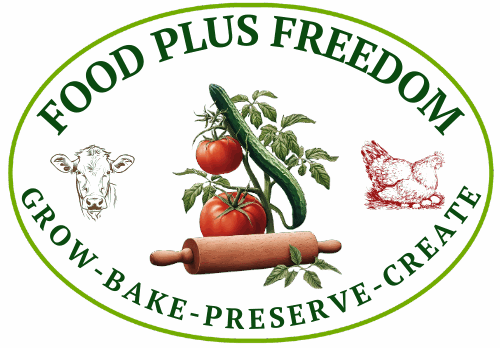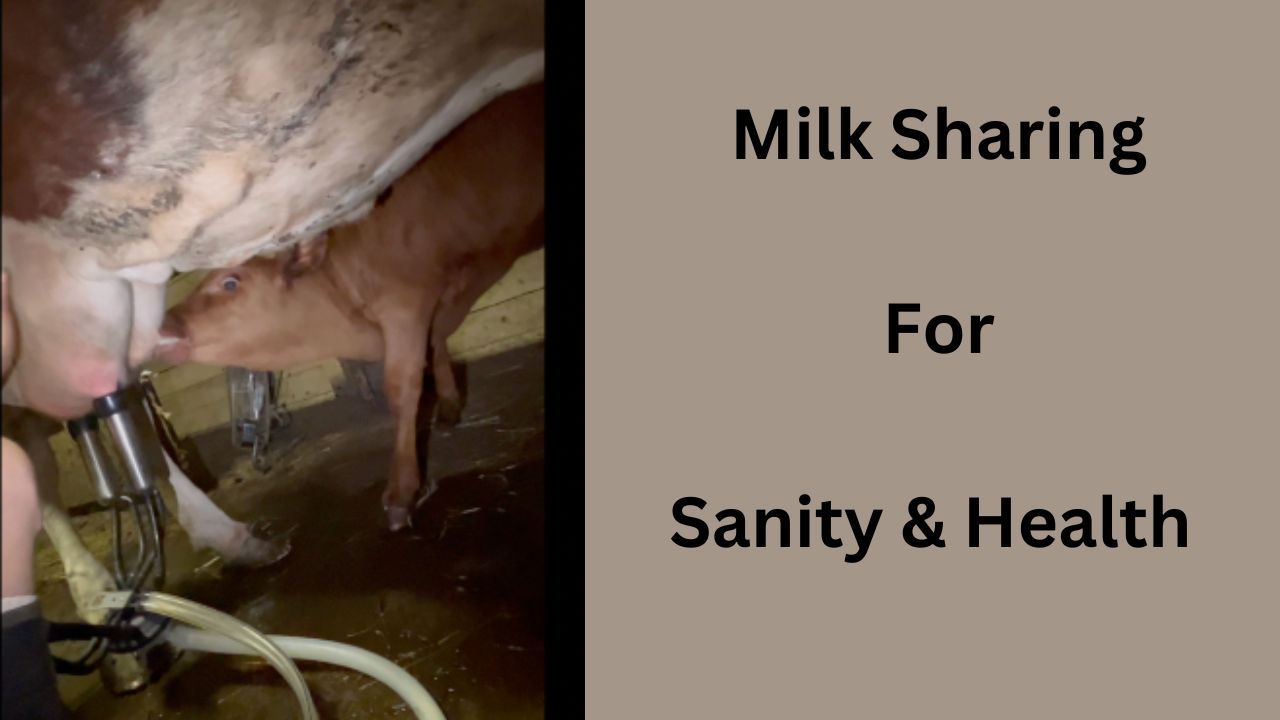Milk sharing allows us sanity while keeping our animals healthy too.
The term milk sharing has many definitions and ideas. On our homestead, we milk share with the calf for our sanity and the health of both the cow and calf. We’ve been milking our cows on and off for the past 14 years and we always milk share with the calf. Why on and off? We do not milk the cow when it doesn’t have a calf on it. The one time we tried milking without the calf nursing, it lasted less than a week. It was stressful for everyone involved, human and animal.
Myths:
Here are just a few myths I’ve heard from dairy farmers in my area who know how we milk.
- Your cow will get mastitis. This is false, a cow gets mastitis from bacteria going into the udder. This is very unlikely when a calf is on the cow, because when a calf has finished eating, its natural means of eating helps close the teat end where the milk comes out keeping bacteria out naturally. If you’re worried about mastitis, be mindful of the fullness of the udder and the temperature. It should never be hot to the touch.
- Your cow will lose its milking amount. Half-False. The cow adjusts to us milking with the calf. Plus, anything we don’t eat the calf does. The cow’s milk will fluctuate with how much the calf is eating plus where the cow is in her cycle.
Your calves won’t get enough to eat, so you’ll need to supplement them. This is false, because the way we milk, as you will read about below, works with nature and not against it. - The calf will not get adequate nutrition if you allow it to feed off its mother, because you don’t actually know how much the calf is eating. It’s true we have no idea how much a calf will eat directly from its mother. It’s false that the calf will not get enough nutrition from the mom. Nature knows best. You need to watch the calf to make sure it is thriving and adjust if there is a problem. You do not need to take over nature, you’re just giving yourself more work and less health for everyone involved.
Remember, you are not a dairy farm, but a homesteader. You do not need to milk like a milk dairy does for your income. Plus, most dairies I know about do not milk and live in harmony with their animals, but use their animals as a tool in their business. The difference is a commercial mindset and a homestead mindset. Yes, I’ve seen different people homestead who grew up on milk dairies and many don’t change their philosophy about milking, because it’s ingrained in them.
You can decide how you want to milk your cow and how to have harmony with nature, too.
How we milk share with our calves?
Let’s start at the beginning or as soon as the cow freshens or has her calf.
The calf is born. As soon as the calf is born, we watch to make sure the calf drinks as much as it can for the first 24 hours. You want to make sure the calf eats within four hours of being born. Most calves start eating within an hour or so. Once the mom has them cleaned up and they are on their feet.
Day 1 to Day 3.
For the first 24 hours, we watch the mom and calf. The calf, to make sure it is nursing and the mom that her udders are getting engorged or swollen where the calf can’t nurse. If the mom’s udder and teat swells so much the calf can’t drink we will milk off some of the colostrum into a glass container and freeze it. If the cow’s udder is not overly swollen, we do nothing.
Do not freeze full glass jars, make sure there is at least two inches of space. We usually put the container in the freezer without a lid to avoid breaking jars, then put the lid on once frozen.
Our Ayrshire milk cow needs us to take some of the colostrum during the first three days in order for the calf to eat. Our Dexter milk cows normally doesn’t need us to do anything.
We also keep the mom and calf inside for this time, to evaluate how the calf and mom are doing. Weather and the Cow determine when we allow the calf and mom to go outside.
Day 4 to 7:
At day four, we milk our cows each morning after the calf has eaten. Some place between day two and day seven, all of our cows have access to the main pasture and barn. Our Cows have access to the pasture and barn at their will. Each night, we separate the milk cows and their calves from the main herd. They have their own area of the barn and small pasture area. The cows are trained through repetition to come in to milk in the morning, so we very rarely have to go to the milk pastures area and get them.
We separate the milking cows at night from the main herd to keep them trained for milking. Once they are milked, they go back in with the main herd for the rest of the day. During this time, the milk is fed to other animals on the homestead. Around day seven the colostrum and or blood in the milk will disappear. We do not separate cow and calf at this point
Day 8 until there is no milk for us in the morning.
Once the milk is clear of colostrum and blood, we use the milk in the house for the humans. When we have extra milk, the animals get some as well.
We continue separating the milk cow from the main herd, as well as milking after the calf has eaten in the morning. The rest of the day, the calf gets whatever milk it wants. There will be a fluctuation in how much milk you get at this point. As the calf eats more, you’ll get less. This is only temporary. The above schedule continues daily until the calf eats all the morning milk and there is none for us.
Some of our calves drink everything by three weeks old, while others take over a month. It depends on the cow and their genetics.
Separating Cow and Calf
Once the calf finishes eating in the morning and we no longer have milk, we separate the cow and calf at night. We have a calf pen, which we call the nursery, that is next to where the cows spend the night. The cow and calf can see each other, touch noses, but not nurse. We wait to separate cow and calf after the calf has eaten its evening meal. We separate them for about 12 hours each night.
Once we get to this stage of milking, we milk two teats and the calf gets two teats every morning. It takes about four or so days for the milking amount to stable out. I am literally milking while the calf is nursing. The calf eats on one side, while I am milking on the other. This allows for the calf to be around us and handled easily. If it’s a heifer (female) calf, we begin its milk training.
Once we’ve kept up the above schedule for a few weeks, we take planned and unplanned days off from milking. For instance, we don’t milk on Sundays. It gives us all a break.
At anytime during our milking, if we need to not milk, we don’t. The calf takes care of the milk we would have milked. This adds to our sanity. We don’t worry about the “what if we can’t milk the cow”. We’ve had emergencies where we haven’t milked for a short period of time, and came back to milking. Plus, when we want to take a few days off the homestead, we don’t have to worry about getting someone to milk for us.
How long do we milk for?
We milk the same schedule as the calves for milking length. All calves stay nursing on their moms for at least six months. We do not let any calves leave the homestead before six months. If we sell a calf from one of the milkers, we will stop milking the cow when the calf leaves the homestead.
We ween heifer calves at 7 months if the bull is still in the pasture. If the bull isn’t still in the pasture, or the calf is a steer we ween by nine months old. This gives the cow three months before they might have their next calf. We milk as long as the calf is on the cow. We have one cow who starts weening her calf around five or six months old. As soon as we noticed her kicking off the calf, we stopped milking as well.
More non-rules of how we milk.
We have one cow we milk by hand and one we milk with a milking machine. I’ve found I can get more milk by hand milking and it’s faster. Once you take into consideration the set up and cleanup of a milker, hand-milking is quicker. Plus, I truly enjoy milking by hand best.
So why do we hand milk one and machine milk the other? Our Ayrshire cow came from a dairy and doesn’t like to be milked her by hand. Since we still had our milking machine, we use it. It’s not worth the stress to retrain her. Plus, while she’s milking I can play with her calf.
One question I get a lot is, “You have to get up early to milk, don’t you?”
I always chuckle because we make our schedule, not the cows on this homestead. When the kids were in school, I milked at 7 am as soon as they left on the bus or after I got back from taking them to school. I didn’t have time to get them ready for school, milk, and get ready for work. I was not going to get up at some crazy early time to milk either. In the summer months, I milked a little later because we could relax and sleep in.
Today, the kids are grown up, Rick is retired from his off the homestead job, and my schedule is flexible. So we milk between 8 and 8:30 am.
When I’ve gone out to the barn before this time, the cows look at me like, “What I’m still sleeping.”
The way we milk works perfectly for us. Our animals are healthy and not stressed, the cows are excellent moms, and we get raw fresh milk. We are less stressed because we milk because we want to, not because we have to for the cow’s health. It’s a win win situation for all animals and humans involved.
If you milk a cow, do it with sanity.
If you haven’t started milking yet, know you can do it on your terms.

